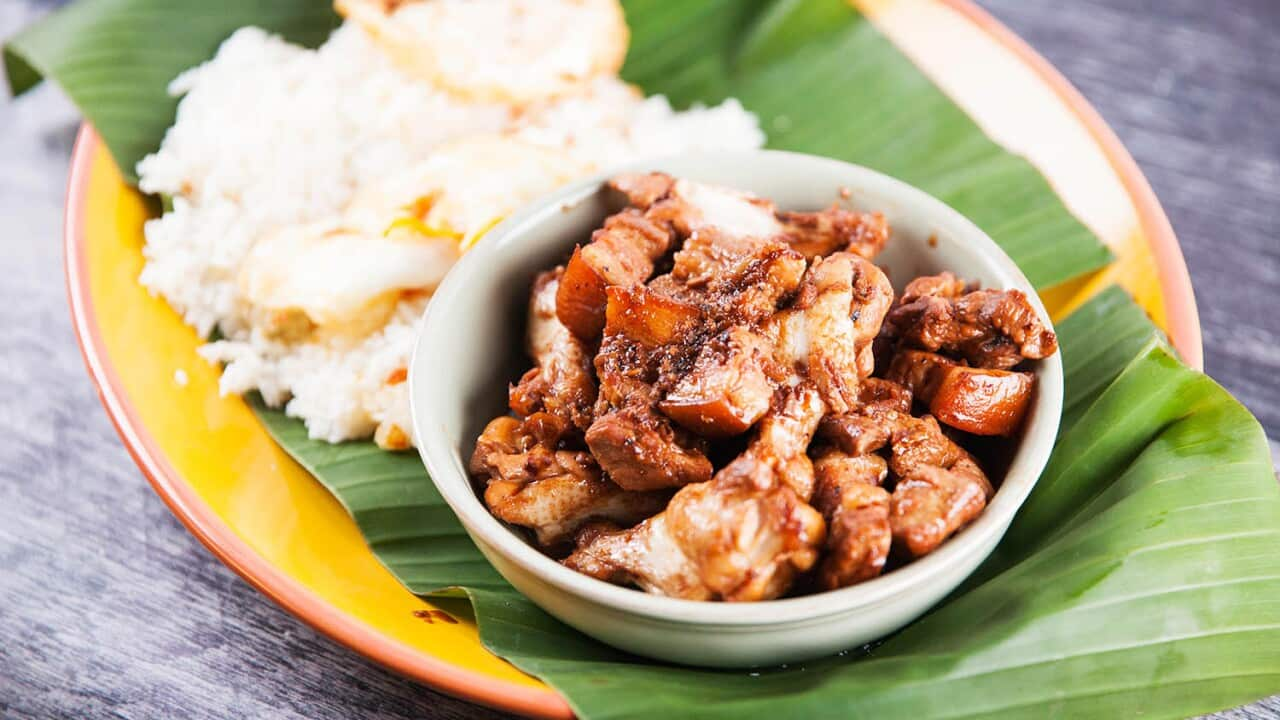As a child growing up in Canada, I don’t remember when I became aware of being half Filipino. Like many kids of migrant families, I knew my family did things other people’s families didn’t do. My maternal relatives all spoke Tagalog, a language I never learned. They greeted me by smooshing their noses into my cheek and inhaling, an act of affection we Western-born cousins dubbed “the sniffy kiss”. At family dinners, we ate dishes like , and .
Some people call those dishes the trifecta of Filipino cooking, while others say the classification is reductive. And fair enough. With over making up the Philippines, the variety of food across the archipelago is mind-boggling.
But as a picky kid who declared my mum’s (fermented shrimp paste) “stinky” and crispy pata (fried pig leg) “gross”, the trifecta was as far as I ever let my Philippine culinary education go, and my favourite dish was adobo. Recipes for it vary from region to region, Lola to Lola (grandmother to grandmother). As far as I can remember, my Lola didn’t make adobo; according to my mum, grandma didn’t like cooking, although she made good spaghetti marinara. Assimilating was probably important to 1960s migrants in Canada. Grandma was an eloquent English speaker, she eschewed her given name, Teofila, opting for the easy-to-pronounce Pat, and of her limited cooking repertoire, that spaghetti was tasty.
Recipes for it vary from region to region, Lola to Lola (grandmother to grandmother). As far as I can remember, my Lola didn’t make adobo; according to my mum, grandma didn’t like cooking, although she made good spaghetti marinara. Assimilating was probably important to 1960s migrants in Canada. Grandma was an eloquent English speaker, she eschewed her given name, Teofila, opting for the easy-to-pronounce Pat, and of her limited cooking repertoire, that spaghetti was tasty.

Don’t be afraid to add sugar to your adobo – it makes for a delicious, sticky sauce. Source: Pilar Mitchell
My mum’s adobo has just a handful of ingredients: soy sauce, vinegar, garlic, bay leaves, peppercorns, coconut milk and so much brown sugar that a friend, whom I shared the recipe with, felt obliged to halve it. Her version might have been healthier, but I can imagine my mum's scolding: “Tsk, sugar in the adobo isn’t going to kill you.”
My mum’s adobo has just a handful of ingredients: soy sauce, vinegar, garlic, bay leaves, peppercorns, coconut milk and so much brown sugar that a friend, whom I shared the recipe with, felt obliged to halve it.
That sweet, salty, vinegary dish has a special place in my heart. When I was a vegetarian for 10 years, chicken adobo was the only meat dish I longed for. Now I have kids of my own, it’s the only dish that all three eat enthusiastically, without complaint.
When you cook it, the sharp smell of vinegar and garlic lingers in the air, underpinned by the clean, earthy scent of steamed rice. Everyone fights to ladle more and more sauce over their rice, the bowl for discarding bones gets passed around, and someone sneaks all the soft chunks of garlic out of the pot for themselves. Eventually everyone is full, but that doesn’t stop you feeling disappointed to discover the rice bowl empty, with nothing left to soak up a bit more sauce. Adobo isn’t a dish that you serve at a fiesta. Those occasions are the domain of (whole roasted suckling pig) or rellenong bangus (stuffed milkfish). Adobo is comfort food. My mum makes it for my sister when she visits from Vancouver, and she leaves with a container of it on the ferry ride back home. Before my parents fly back to Canada after their biennial Sydney trip, my mum makes a big pot for my family. Adobo is the final act of nurturing before saying, 'bye for now'.
Adobo isn’t a dish that you serve at a fiesta. Those occasions are the domain of (whole roasted suckling pig) or rellenong bangus (stuffed milkfish). Adobo is comfort food. My mum makes it for my sister when she visits from Vancouver, and she leaves with a container of it on the ferry ride back home. Before my parents fly back to Canada after their biennial Sydney trip, my mum makes a big pot for my family. Adobo is the final act of nurturing before saying, 'bye for now'.

Chicken adobo: just one of many classic Filipino dishes worthy trying. Source: Benito Martin
As a half Filipina, half Canadian, I’ve often thought that existing between two worlds is a strange, sometimes lonesome thing. You’re always hoping one side or the other will finally say, “You belong with us.” But I’m beginning to realise, being both is not only okay, it’s who I am.
My mother is from Manila, my father is from Manitoba. English is my mother tongue and whenever I bring food to a party, even though it’s not considered party food, I bring a pot of adobo.
Serves 4-5
Ingredients
Sauce
- 1 cup soy sauce
- ¾ cup brown sugar, loosely packed
- ½ cup white vinegar
- 5 large bay leaves
- 1 tbsp peppercorns
- 1 head of garlic, peeled
- 400 ml tin coconut milk
Chicken
- 6 chicken drumsticks
- 6 chicken boneless, skinless thighs
- Steamed rice, to serve
- Steamed broccoli or greens, to serve
Method
- To create the marinade, combine all the sauce ingredients – except the coconut milk – in a large pot. Stir the ingredients until the brown sugar dissolves. Add chicken pieces to the pot and cover with the sauce. Leave to marinate for at least four hours. You can leave the chicken overnight in the fridge to marinate for longer if you like.
- Place the pot of marinated chicken on the stove over high heat and bring the pot to boil. Reduce the heat to medium and gently boil for 10 minutes, uncovered. Reduce the heat to a minimum and simmer for 25 minutes.
- Add coconut milk to the pot and increase the heat until the liquid is boiling. Reduce to a low heat for 20 minutes.
- Serve with steamed rice and broccoli or greens of your choice.
Filipino flavours

Filipino chicken adobo











